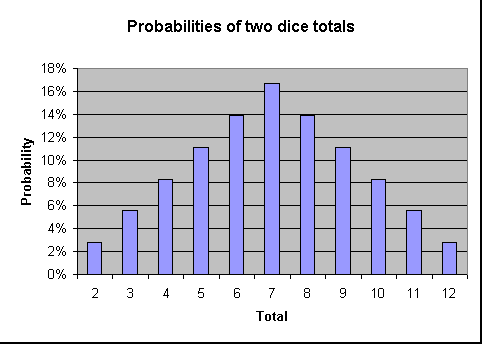If you don't want to calculate dice roll probabilities you won't want to read this.
Anydice.com is good for simple things, but I don't understand how to calculate probabilities for "If the lowest die is a 3 then roll an extra die unless.." rules that you sometime have in board games.
Here is a Javascript program that rolls dice with any number of sides, any number on each face of the dice, and any kind of rules you want to implement. Here I use a "If either die is Zero, re-roll one die that is zero" function, it isn't difficult to program different rules.
The program just makes lots of dice rolls and takes an average.
 |
red = [1, 2, 3, 0, 0, 0], //Red Space Crusade die
white = [1, 2, 0, 0, 0, 0], //White Space Crusade die
|
Here is a simple Javascript program that rolls:
2 white Space Crusade dice (see above picture), rerolling one zero value.
2 red Space Crusade dice, rerolling one zero value.
2 D6 dice, simple total.
For example, this function rolls 2 dice and returns the total. The dice can have any number of sides, and any number on each side. You can use if/then/else statements to handle things like doubles or snake eyes.
function rollTwo(colorDie) {//simple total
var die1, die2;
die1 = rollDie(colorDie);
die2 = rollDie(colorDie);
return die1 + die2;
}
The "trials" function takes the dice, number of rolls, and the function to apply:
function trials(diceArray, times, funct) {
var i, roll, result = [];
for (i = 0; i < times; i++) {
roll = funct(diceArray);
while (result.length < roll + 1) {
result.push(0);
}
result[roll] = result[roll] + 1;
}
return result;
}
The "displayResult" function just creates a display string from the contents of the "result" array.
There is a paragraph in the .html to display the result string.
That's about it.
Sample output:
The rolls were
0: 29.34 %
1: 22.1 %
2: 29.05 %
3: 12.61 %
4: 6.9 %
The rolls were
0: 12.72 %
1: 13.07 %
2: 17.71 %
3: 23.4 %
4: 16.35 %
5: 11.31 %
6: 5.44 %
The rolls were
0: 0 %
1: 0 %
2: 2.75 %
3: 5.64 %
4: 8.24 %
5: 11.06 %
6: 13.89 %
7: 16.21 %
8: 13.78 %
9: 11.36 %
10: 8.79 %
11: 5.51 %
12: 2.77 %
The chart gives the same numbers as the text output above it, 7 is 16.21 % (16.67 % is the correct answer) for example.
The program rolls the dice 10,000 times, so you never get exactly the same numbers.
If you copy and paste the text below into a text editor and save it as "whatever.html", you can click on the file and it runs in the browser. Or run the program from
here.
<===================== below this line is the program ========================>
<!DOCTYPE html>
<html>
<body>
<p id="white"></p>
<p id="red"></p>
<p id="d6"></p>
<script>
var white = [0, 0, 0, 0, 1, 2], //White Space Crusade die
red = [0, 0, 0, 3, 1, 2], //Red Space Crusade die
d6 = [1, 2, 3, 4, 5, 6], //Normal D6
d10 = [0, 1, 2, 3, 4, 5, 6, 7, 8, 9, ], //Normal D10
result;
document.getElementById("red").innerHTML =
"Calculating";
document.getElementById("white").innerHTML =
"Calculating";
document.getElementById("d6").innerHTML =
"Calculating";
result = trials(white, 10000, rerollOne);
document.getElementById("white").innerHTML =
"The rolls were <br>" + displayResult(result, 100) + " ";
result = trials(red, 10000, rerollOne);
document.getElementById("red").innerHTML =
"The rolls were <br>" + displayResult(result, 100) + " ";
result = trials(d6, 10000, rollTwo);
document.getElementById("d6").innerHTML =
"The rolls were <br>" + displayResult(result, 100) + " ";
function displayResult(anArray, divide) {//result array, divisor for output to make it look like a percentage
var i, limit, str = "";
limit = anArray.length;
for (i = 0; i < limit; i++) {
str += i;
str += ": ";
str += anArray[i] / divide;
str += " %<br>";
}
return str;
}
function trials(diceArray, times, funct) {//die array, number of iterations, function to use
var i, roll, result = [];
for (i = 0; i < times; i++) {
roll = funct(diceArray);
while (result.length < roll + 1) {//make result array bigger if needs be
result.push(0);
}
result[roll] = result[roll] + 1;
}
return result;
}
function rollDie(colorDie) {//returns a random die roll result
return colorDie[randIndex(colorDie.length)]
}
function randIndex(num) {
return Math.floor((Math.random() * num));
}
function rollTwo(colorDie) {//simple total
var die1, die2;
die1 = rollDie(colorDie);
die2 = rollDie(colorDie);
return die1 + die2;
}
function rerollOne(colorDie) {// if one result is zero, reroll it
var die1, die2, reroll;
die1 = rollDie(colorDie);
die2 = rollDie(colorDie);
reroll = rollDie(colorDie);
if (die1 === 0) {
die1 = reroll; //reroll first die if zero
} else {
if (die2 === 0) {
die2 = reroll; //otherwise reroll second die if zero
}
}
return die1 + die2; //total of 2 dice
}
</script>
</body>
</html>





















